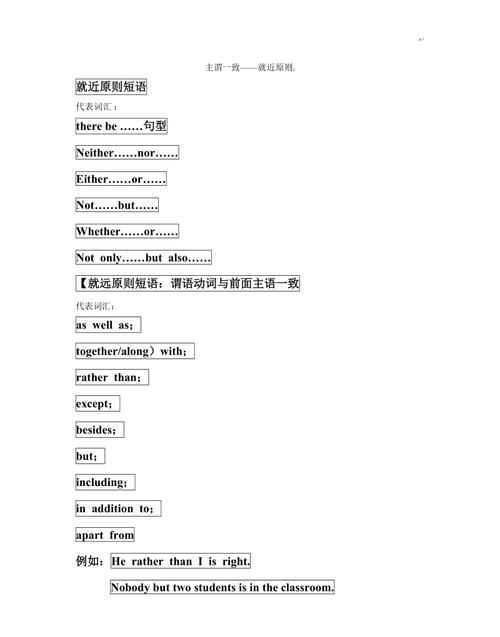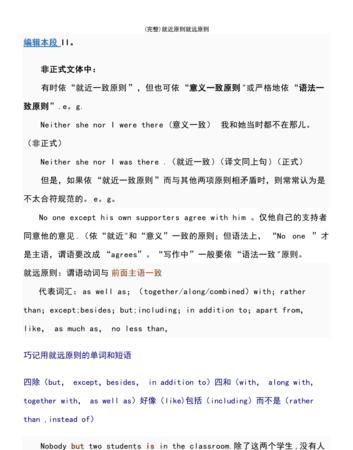本文目录
初中阶段就近原则有哪些
就近原则也称“邻近原则”“就近一致原则”,即:谓语与靠近的名词、代词在“人称、数”上一致。接下来分享初中就近原则的5个例子。

正式文体中:
1.由下列词语连接的并列主语:"there be+句型; or ; either …or;nor; neither…nor;whether…or;not…but; not only…but also" 等。
(1)Not his parents but he doesn’t want to go. 是他的父母亲不想去而不是他不想去。
(2)There is an apple, two pears and some oranges on the plate. 盘子里有一个苹果,两个梨子跟一些桔子。
(3)Neither you nor I am a stranger here.你和我都不是刚来这里。
(4)You or he is going to be sent to study abroad.你或者他将要被送出国。
(5)Neither you nor I am wrong .你和我都没错。
2.在倒装句中:谓语可与后面第一个主语一致。
(1)There is (are) a pen and some books on the desk .桌上有一支钢笔和几本书。
(2)In the distance was heard the clapping of hands and the shouts of the people .在远处,能听见鼓掌声和人们的呼喊声。
(3)There are two pears, some oranges and an apple on the plate. 盘子里有两个梨子,一些桔子和一个苹果。
(4)There is a pen and some books on the desk.桌上有一支钢笔和几本书。
(5)There are some books and a pen on the desk.桌子上有几本书和一支钢笔。
非正式文体中
有时依“就近一致原则”,但也可依“意义一致原则”或严格地依“语法一致原则”。
(1)Neither she nor I were there. (意义一致) 我和她当时都不在那儿。(非正式)。
(2)Neither she nor I was there .(就近一致)。
(3)No one except his own supporters agrees with him .(语法一致)仅他自己的支持者同意他的意见。
neither nor就近原则造句
neither nor就近原则:即谓语与靠近的名词、代词(有时不一定是主语)在人称与数上保持一致的原则。
扩展资料
就近原则怎么理解
这个类型的句子肯定有两个主语,后面的谓语动词和与它靠得最近的主语保持一致。
例如,neither you nor I am happy(我和你都不高兴)。这个句子里面有两个主语,一个是 you,另一个是I,和谓语动词靠得最近的就是主语I,那么谓语动词就和I保持一致,所以后面使用am。
neither nor就近原则及例子
neither nor需要就近原则。就近原则,也称“邻近原则”“就近一致原则”,即谓语与靠近的名词、代词(有时不一定是主语)在人称与数上保持一致的原则。
常见的需要就近原则的:
1、由here,there,where等引导的倒装句中,(有时主语不止一个时)谓语动词与靠近它的主语在数上一致。
如:Here comes the bus.公共汽车来了。
Here is a pen and some pieces of paper for you.给你一支钢笔和几张纸。
Where is your wife and children to stay while you are away?你不在这儿的`时候,你爱人和孩子在哪儿呆呢?
2、用连词or,either....or,neither…nor,not only…but also等连接的并列主语,谓语动词与靠近它的主语在数上一致。
如:Neither the students nor the teacher knows anything about it.学生和老师都不知道这事.
He or you have taken my pen.他或你拿了我的钢笔。

关于就近原则的句子
就近原则也称"邻近原则""就近一致原则",即:谓语与靠近的名词、代词(有时不一定是主语)在"人称、数"上一致。与其相对的还有"就远原则"。
There is an apple and some oranges .
Either You or I am going there Tomorrow.
Nither my father nor my mother is at home today.
There are some books and a pen on the table.
She likes neither butter nor cheese.
Neither dad nor mum is at home today.
He is neither tall nor short. He is medium height.
She is either drunk or mad.
Many other experts insist this is not an either or situation .
When the girl is happy, she either sings or dances.
Either you or I am going there tomorrow.
Either the teacher or the students are our friends.
His brothers or Tom is waiting in the room.
Neither they nor he is wholly right.
There is a pear and two apples in the bag.

英语主谓一致就近原则有哪些
1,当两个主语由or, either …or, neither …nor, whether…or…, not only…but also连接时,谓语动词与邻近的主语一致。
例如:Either the teacher or the students are our friends.
若交换一下主语,则为Either the students or the teacher is our friends.
Tom or his brothers are waiting in the room.
若交换一下主语,则为His brothers or Tom is waiting in the room.
Neither they nor he is wholly right.
此句若交换一下主语,则为Neither he or they are wholly right.
2.there be 句型中be动词单复数取决于其后的主语。若主语由and连接,则应与靠近的那个主语保持一致。
例如:There are two apples and a pear in the bag.
此句若这样,则为There is a pear and two apples in the bag.
注意:Here引导的句子用法同上。
下面以习题的形式为大家巩固此语法点。
1.Either you or one of your students_____to attend the meeting that is due tomorrow.
A.are B.is C.have D.be
解析:答案B.
此题考查的主谓一致,按照就近原则,one of your students 的中心词为one,谓语动词应为单数,故选B.
2.Neither Tom nor Jack and I____his students.
A.are B.am C.is D.was
解析:答案A.
此题考查的主谓一致,按照就近原则,Jack and I是两个人,谓语动词应为复数,故选A.
如果nor后只有I,则可选B.
3.Not only my brother but also I____good at painting. Both of us ____good painters.
A.are; are B.am; am C.am; are D.is; is
解析:答案C.
此题考查的主谓一致,按照就近原则, I 与am搭配;both of us为复数,与are 搭配,故选C.
4.There ____a pen, two pencils and three books on the desk.
A.are B.is C.has D.have
解析:答案B.
此题考查的主谓一致,按照就近原则,a pen为单数,谓语动词应为is, 故选B.
主谓一致的就近原则很固定,大家要牢记这些词,随机运用即可。Master Osifu English就讲到这里。

以上就是关于就近原则的例题 ,初中阶段就近原则有哪些的全部内容,以及就近原则的例题 的相关内容,希望能够帮到您。
